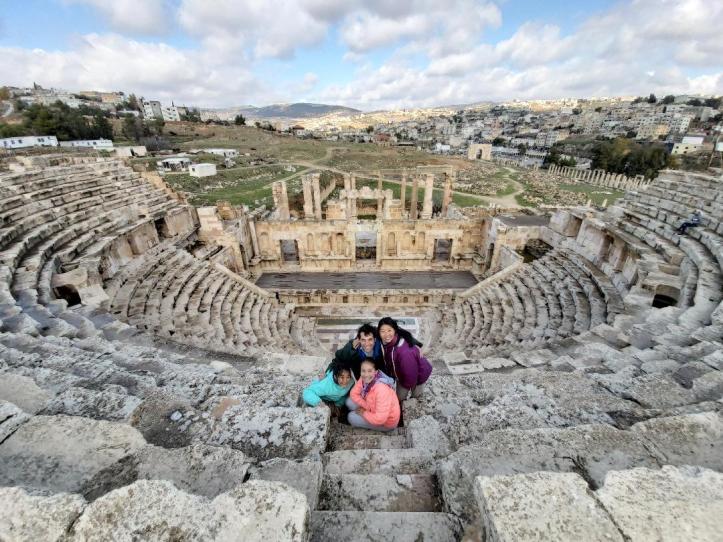Outside of Amman was the historical city of Jerash. Even though it was rainy and cold, we decided to make the journey there. We were not disappointed.

History of Jerash
One of the monumental and most integrated among the oldest levant cities built by the Romans. Over the history the city of Jerash had been known as Jerasho, Antioch, Gerasa, Jerash, and Pompei of the middle East. The one thousand column-city locates about 570 meters above sea level.
Jerash was founded during the fourth century B.C under Alexander of Macedon. Jerash in Roman era was experiencing its golden age from the year 63B.C. Lasting 400 years beyond. The 3453 long wall embraces Jerash with four gates and crossed by the Jerash Valley (Gold River) dividing the city into 2 east and west parts linked by 2 bridges one of the still in use to date.
The most important parts of the city are 2 main colonnaded streets (Cardo and Dycamanos), and other huge monumental structures like the temples (Zeus, Artemis), theaters (north theather and south theater), bathes (west bath, and east bath), plazas and bazaars, Nymphaeum, symmetries shelters, shops, triumphal arch, and drainage channels.
Historically, Jerash was one of the decapolis league. Its population was 20,000 individuals and visited by the Roman Emperor Hadrian in 130 A.C.
Christianity was known in Jerash by the year 350AD, and ruins of sixteen churches built between the 4th and 7th centuries AD still exist today. Most prominantly, the Cathodral, Church of Bishop Assiah, Churchas of St. Theodore, Church of Saints Cosmas and Domian, Church of Saint George, Church of Bishop Genesius, Church of Mortuary, etc.
By 635 AD Jerash was dominated by the Islamic State. One of the most monumental discoveries was a mosque amidst a populous neighborhood dates back to the Umayyad age. In 749 AD, the city was wrecked by an earthquake that destroyed most of its milestones.
In 1120 AD Jarash served as center of a Seijuk garrison stationed in the temple of Artemis, which in turn was demolished by Crusade Jerusalem Kingdom Troops in 1121 AD. By the end of the Ottoman reign Jerash was the Office of the Qaem Maqm (Ottoman House), which latterly was used as the first office of the Jordanian Department of Antiquities. – From the placard on the South Entrance to the site. (Another history here (click here)
Jerash was mentioned in the Bible in Matthew 4:23 and Mark 7:31. Found were skulls from the Neolithic period (7500-5BC) and tools from the bronze age (3200BC – 1200BC). Civilizations confirmed to have lived there span from the ancient Greeks (under Alexander the Great), to the Romans, Islamic, and Ottomans. Different scholars point to Egypt under Ptolomy II and to Antioch IV of Macedon as other potential creators of the city. It was great to explore a location with a such a rich and diverse history.
The sites!
With so many nooks and crannies to explore, Kylie went wild. We strolled down the colonnaded street and admired the Nymphaeum. We also marveled at the mosaic floors of some of the early churches built here. We enjoyed the two theaters and found the focal point of the theaters to hear our echos. We also explored the temple of Zeus and Artemis. Seeing ancient technology was also fascinating. From bath houses and hydraulic powered stone cutter, to olive presses, there was a lot to explore and learn.
Getting there and back
We took a taxi to the North Bus Station. We had to wait until the bus was full. After waiting for nearly an hour, the bus took off. It was a quick 40 minute ride. We missed our stop in front of the visitor center, so we had to walk back a bit. This bus was considerably cheaper than the 40JD quotes from private drivers to Jerash and back.
On our way back we walked to the South Gate where the local bus leaves. Many private drivers approached us to offer rides but we found a driver who already had one passenger and was willing to take us all back for 6JD (2 more than the bus). We didn’t mind sharing a ride. We certainly didn’t want to wait another hour for the bus to fill up.
Just looked around at the civilization time line! WOW. Did you create this?? I need to spend some real time sitting with this. Mind-blowing.
LikeLike
Thank you for the kind comment! One of the challenges for me is documenting our trip and putting what we’ve learned and where we’ve been into perspective. How old is old and how long did a civilization last is interesting. It is also interesting to see how long a location has been in use and for how long. I’m hoping it helps when the kids hit world history and they can contextualize their experience with what they see in the books. -Dan
LikeLike
Man, I totally understand and am going to use as well. Very cool contextual historical timeline. We use a history curriculum that tries to paint a picture of what was happening around globe from ancient to current and your timeline really is an awesome visual.
LikeLike
Thank you. I need to update it. I’m trying to tie to places we’ve been. I’m a little torn on how to handle a place that was made on top of a older site, but then re-purposed, but used continuously, but that’s why I don’t get paid the big money. Thank you again. Cheers.
LikeLike
very cool challenge! almost visualize those like transparent sheets of paper we used to use (maybe your not old enough) to make overheads where you could almost visually and contextually layer civilizations….hmmm…
LikeLike